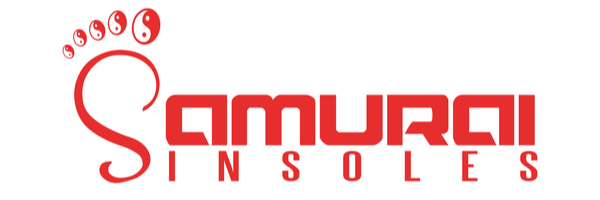Let's get right to the question that's probably on your mind: How long does plantar fasciitis last? The honest answer is that for most people, it takes consistent effort and simple treatments to feel better, usually within 6 to 12 months.
Think of your plantar fascia—that thick band of tissue under your foot—as a rope that's become frayed from being pulled too tight for too long. Healing is all about giving that rope some slack and the time it needs to weave itself back together.
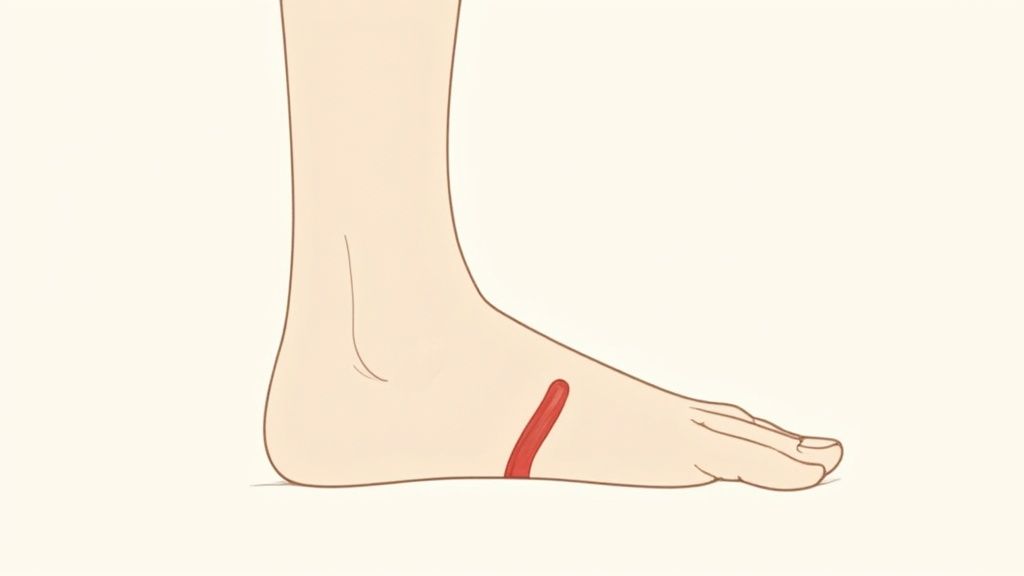
Your Plantar Fasciitis Recovery Timeline Explained
Understanding what to expect on your road to recovery is one of the most powerful tools you have. It helps you stay patient and motivated. Getting from that first painful step in the morning to walking without a second thought isn't an overnight fix. It’s a gradual process that happens in stages.
This guide will map out that journey for you, breaking down what recovery looks like week by week and month by month. Knowing what’s ahead helps you navigate the ups and downs with more confidence.
To give you a clearer picture, let's look at the typical stages of healing from plantar fasciitis. This table breaks down the general timeline, from the initial shock of acute pain to the final phase of getting back to your normal routine.
| Recovery Phase | Typical Timeline | What to Expect |
|---|---|---|
| Phase 1: Acute Pain & Inflammation | First 2-4 weeks | Sharp pain, especially in the morning. Focus is on rest, icing, and reducing inflammation. |
| Phase 2: Healing & Rebuilding | 1-6 months | Pain transitions to a dull ache. This is the crucial time for consistent stretching and strengthening. |
| Phase 3: Strengthening & Return to Activity | 6-12+ months | Pain is minimal or gone. The goal is to build resilience to prevent it from coming back. |
Remember, this is a general guide. Your personal timeline will depend on how consistently you stick with your recovery plan and how your body responds.
The Initial Phase of Acute Pain
Those first few weeks are often the toughest. The pain is at its sharpest, and that first step out of bed can be excruciating. During this initial phase, the goal is simple: calm everything down. You need to reduce the inflammation and take the stress off your plantar fascia.
Your main jobs during this period are:
- Rest and Modify Your Activities: This is non-negotiable. You have to back off from high-impact activities like running, jumping, or long hours of standing.
- Ice Your Heel: Applying ice for 15-20 minutes a few times a day is a game-changer for managing pain and swelling.
- Start Gentle Stretching: Simple stretches for your calf and the bottom of your foot help lengthen the muscles and tendons that are pulling on that frayed "rope."
The Healing and Strengthening Phase
Once you get past the initial acute phase (which can take a few weeks to a couple of months), you move into a much longer period of active healing. The sharp, stabbing pain might fade into a dull, persistent ache, but don't be fooled—the tissue is still very much in repair mode.
This is where consistency becomes your best friend. Many people start to feel a bit better and wonder, does plantar fasciitis go away on its own? The reality is that active treatment is what leads to real, lasting relief. During this phase, you'll be focusing on building up strength and flexibility to make your foot more resilient and prevent this from happening all over again.
The good news is that the simple, non-surgical treatments really do work for the vast majority of people.
The statistics are incredibly encouraging. Research shows that about 75% of people with plantar fasciitis find relief within a year using only these conservative methods. Most feel a noticeable improvement soon after starting basic treatments like stretching. You can find more details on these plantar fasciitis statistics on WebMD.com.
While that’s great news, it’s a marathon, not a sprint. Healing takes time. For the small number of people whose pain just won't quit, surgery might become a consideration, but that’s only for about 5% of cases. Your success truly depends on sticking to your plan and not trying to rush back to your old activities too soon.
Key Factors That Influence Your Healing Speed
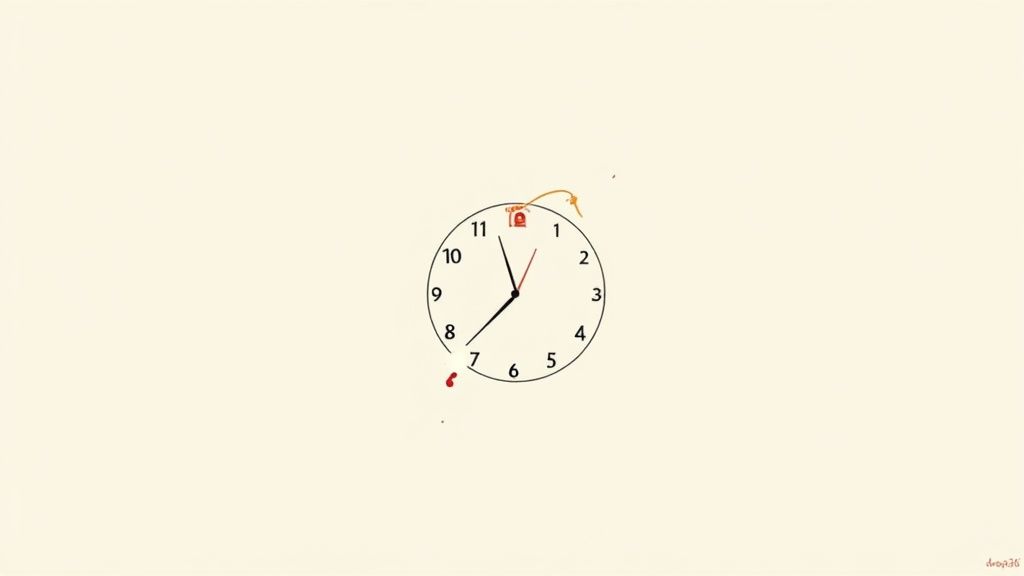
Ever wonder why your friend's heel pain disappeared in six weeks while yours has stuck around for six months? It’s because plantar fasciitis recovery isn't a one-size-fits-all deal. Your body, your lifestyle, and your habits all mix together to create a unique timeline for healing.
Think of it like a road trip. Everyone's goal is to get to a pain-free destination, but the starting point, the car you're driving, and the traffic you hit along the way are different for each person. Knowing what these factors are puts you back in the driver's seat of your own recovery.
Your Age and Body Weight
Two of the biggest players in your recovery journey are your age and your weight. As we get older, our body’s natural repair crew just doesn’t work as fast as it used to. Tissues like the plantar fascia also lose some of their elasticity, making them easier to injure and slower to heal.
On top of that, extra body weight adds a significant, constant load to your plantar fascia. Every pound you carry translates to several pounds of pressure on your feet with every step. This means that even a small amount of weight loss can dramatically reduce that daily strain, giving the inflamed tissue a real chance to mend.
Your Job and Daily Activities
What you do all day, every day, has a massive impact on how long plantar fasciitis lasts. If your job keeps you on your feet for hours on hard floors—like nurses, retail workers, or teachers—your feet are under relentless stress. That constant pressure makes it incredibly difficult for the inflammation to calm down.
The same goes for your activity level. Runners, dancers, or anyone involved in high-impact sports often face a longer road to recovery. The repetitive pounding can keep re-injuring the plantar fascia, setting back your progress.
A marathon runner and an office worker with the same diagnosis will have completely different recovery experiences. It’s why some people are back on their feet in a few weeks, while others are still struggling months later. You can learn more about this timeline from the experts at Florida Foot Specialists.
The Shoes You Wear (and Don't Wear)
Your footwear is a game-changer, but it's something people often overlook. Wearing unsupportive shoes—think flimsy flip-flops or old, flattened-out sneakers—is like asking an injured player to keep running sprints. Good shoes with solid arch support and cushioning act as a crucial support system, taking the pressure off your plantar fascia.
And this doesn't stop when you walk in your front door. Going barefoot on hard tile or wood floors at home can be one of the biggest culprits in derailing your recovery. It puts maximum strain right on your arch, undoing all the good your supportive shoes did during the day. Keeping a pair of supportive slippers or house shoes on can make a world of difference. Understanding what causes plantar fasciitis in the first place can help you make smarter choices for your feet.
How Quickly You Take Action
This might be the most critical factor of all: how fast you respond to the pain. So many of us try to "walk it off" or push through that initial heel ache, hoping it’ll just fade away. This is almost always a mistake.
When you ignore those first warning signs, you allow a small, manageable strain to become a chronic, stubborn problem. Early intervention is everything. The sooner you start simple, effective treatments—like resting, icing, stretching, and using quality insoles—the better your odds are for a quick and complete recovery.
Think of your plantar fascia as a rope. Addressing the pain early is like fixing a few frayed strands. Waiting is like letting the whole rope unravel until it's about to snap, which takes a whole lot longer to fix.
A Realistic Look at Treatment Timelines
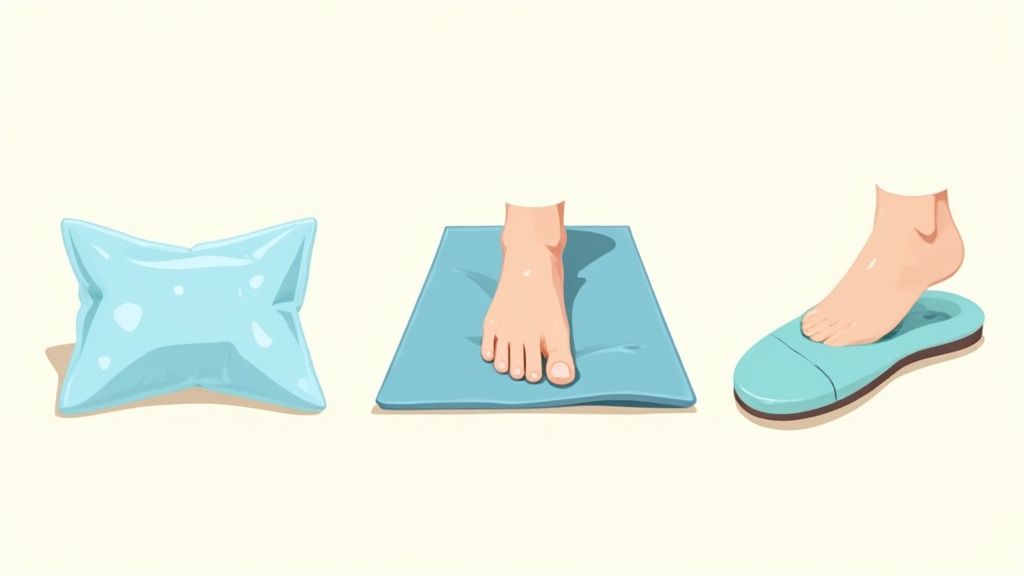
When you're dealing with that sharp, stabbing heel pain every day, the first question on your mind is, "How long will this last?" The answer almost always comes down to the treatments you choose. Getting better isn't about finding a single magic bullet. It’s about layering different strategies that work together to calm down the inflammation, support your arch, and give that damaged tissue a real chance to heal.
Let's walk through the most common treatments, starting with simple things you can do at home and moving up to more advanced medical options. This will give you a realistic idea of what to expect and help you set practical goals for getting back on your feet, pain-free.
Foundational At-Home Care
Think of this as your first line of defense. These are the simple, effective steps that form the foundation of any good recovery plan. You can often start feeling some initial relief within the first one to three weeks just by being consistent.
- Icing and Rest: As soon as pain flares up, icing your heel for 15-20 minutes a few times a day is a must. It’s a straightforward way to reduce inflammation and get some quick pain relief. At the same time, give your foot a break by backing off high-impact activities like running or jumping.
- Stretching: This part is non-negotiable. Gently and consistently stretching your calf muscles and the plantar fascia itself helps lengthen the tight tissues that are pulling on your heel. Make it a habit first thing in the morning and a few times throughout the day.
- Supportive Footwear and Insoles: Wearing shoes with good arch support is vital—all the time. At home, that means no more barefoot walking on hard floors; switch to supportive slippers or sandals. For your day-to-day shoes, a quality pair of insoles can give your plantar fascia the targeted support it desperately needs.
Most people notice a real drop in pain within a few weeks of diligently following this routine. Just remember, this is the start of the healing process, not the finish line.
Professional Support and Interventions
If you've been consistent with at-home care for a few weeks and still aren't getting enough relief, it's time to call in the professionals. These next-level treatments can seriously speed up your recovery, especially for more stubborn cases.
Physical Therapy A good physical therapist can be a game-changer. They'll design a program of specific stretches and strengthening exercises just for you. They might also use hands-on techniques like massage or therapeutic ultrasound to boost the healing process. Patients often report significant improvement within 4 to 8 weeks of starting a consistent PT regimen.
Orthotics and Night Splints While store-bought insoles help a lot of people, custom-molded orthotics from a podiatrist offer support that’s perfectly tailored to your foot. Likewise, a night splint holds your foot in a gentle stretch while you sleep, which can make a huge difference in that dreaded morning pain.
One thing I can't stress enough is consistency. Your recovery timeline can range from a few weeks to over a year, but sticking to your treatment plan is the single biggest factor. For example, patients who wear their orthotics daily and follow their therapist's instructions often find relief in about 6 weeks. You can learn more about what to expect at Sydney Heel Pain Clinic.
Advanced Medical Treatments
For the small number of people whose pain just won't quit after six months of conservative care, a doctor may suggest more advanced options. These are usually considered only when the pain is chronic and really impacting your quality of life. Understanding how to cure plantar fasciitis sometimes means exploring every tool in the toolbox.
Here’s a quick look at what those treatments involve:
- Corticosteroid Injections: A steroid shot can deliver powerful, short-term relief by knocking out inflammation. You might feel better within days, and that relief can last for weeks or months. This creates a valuable window where you can engage more effectively in your physical therapy. Because of potential side effects, doctors use them sparingly.
- Extracorporeal Shockwave Therapy (ESWT): This is a non-invasive procedure that uses sound waves to kickstart blood flow and healing in the damaged fascia. It usually requires a few sessions, and many people report a noticeable improvement within 3 months.
- Surgery: This is truly a last resort, reserved for the most severe cases (fewer than 5% of all patients). The procedure involves surgically releasing a part of the plantar fascia to relieve tension. Keep in mind that recovery from the surgery itself can take several months.
By understanding this treatment ladder, from simple stretches to surgery, you can have a much more productive conversation with your doctor and take control of your own recovery journey.
Common Mistakes That Prolong Plantar Fasciitis Recovery
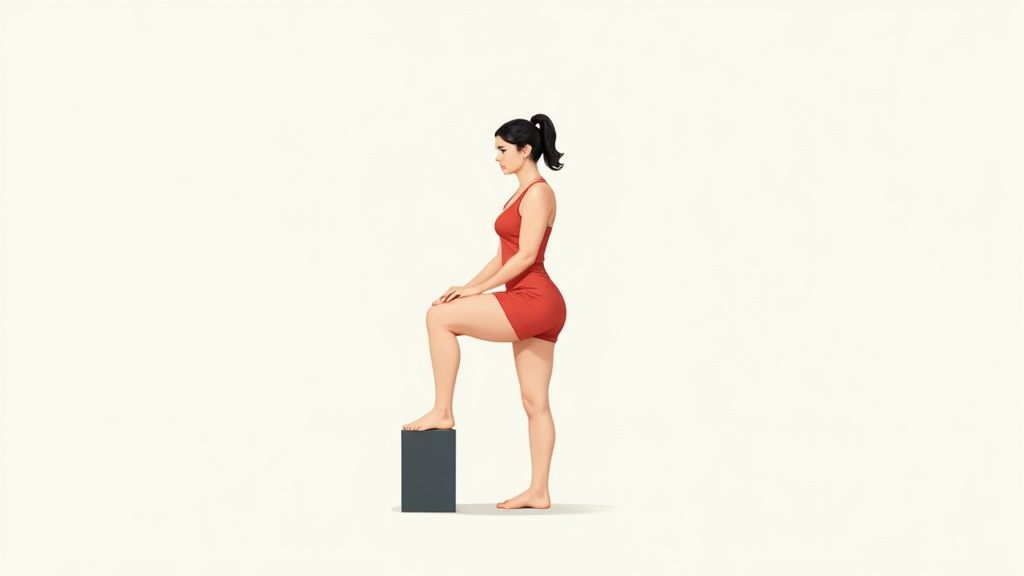
Sometimes, the real question isn't what you should be doing, but what you might be doing wrong. Healing is a delicate balance, and a few common missteps can easily derail your progress, leaving you stuck in that frustrating cycle of pain.
Think of your healing plantar fascia like freshly poured concrete. It needs time and the right conditions to cure and harden. Every mistake is like someone walking through that wet concrete—it weakens the structure and messes up the whole project.
By steering clear of these common pitfalls, you can get back on the right track and shave a significant amount of time off your recovery.
Pushing Through the Pain
This is the big one. So many of us are wired with a "no pain, no gain" attitude, but when you're dealing with plantar fasciitis, that mindset is your worst enemy. It's a direct path to a much bigger, more chronic problem.
Pain is your body's built-in alarm system. It’s screaming at you that the tissue is overloaded and desperately needs a break. Pushing through activities that trigger that sharp heel pain means you're literally re-injuring the inflamed fascia with every step. You’re preventing those tiny tears from ever getting a chance to heal.
Remember that frayed rope analogy we talked about? Pushing through the pain is like grabbing that rope and deliberately pulling the strands apart every single day, somehow expecting it to get stronger. It won't. Healing starts with reducing the load, not adding to it.
Neglecting Your Feet at Home
So, you’ve got a great pair of supportive shoes for work or your daily errands. That’s fantastic. But what happens the second you walk through your front door? If you're like most people, you kick off your shoes and pad around barefoot on hard tile or wood floors.
This is a massive recovery setback. Going barefoot on hard, unforgiving surfaces puts an enormous amount of strain right on your arch and plantar fascia. It completely negates all the good work your supportive shoes did throughout the day.
Your At-Home Footwear Plan:
- Get Dedicated House Shoes: Find a comfortable pair of slippers or sandals that have good arch support. These are for indoor use only.
- No More Barefoot: Make it a hard-and-fast rule. Always have supportive footwear on, especially when you take those first agonizing steps out of bed in the morning.
Inconsistency with Stretches and Exercises
Stretching your calves and the plantar fascia itself is a cornerstone of getting better. These simple movements help to gently lengthen the tight tissues that are constantly yanking on your heel bone. But doing them just once in a while, or only when the pain flares up, simply won't cut it.
Consistency is everything. The whole point of these exercises is to create real, lasting change in the flexibility of your muscles and fascia. That takes a daily, dedicated effort. When you skip days, you allow all that tightness to creep right back in, pretty much hitting the reset button on your progress.
Treat your stretches like a prescription you have to take every day. You wouldn't expect an antibiotic to work if you only took it sporadically, right? The same logic applies here. Making these stretches a non-negotiable part of your daily routine is one of the most powerful things you can do to speed up your healing. It’s a small investment of time with a massive return for your foot health.
When Your Plantar Fasciitis Just Won't Get Better
You've done everything by the book. The diligent stretching, the icing, the supportive shoes—you've been consistent, but that sharp, nagging heel pain is still there. It's a frustrating spot to be in, and if you feel like your recovery has hit a wall after a few months, it's a clear sign you might be dealing with more than a straightforward case.
Feeling stuck is disheartening, I get it. But it's not a dead end. Think of it as a signal from your body to dig a little deeper, ask some tougher questions, and explore the next level of care. Figuring out why your healing has stalled is the first real step toward getting back on the right path.
Signs Your Recovery Has Stalled
So, how can you tell the difference between a slow heal and a truly stuck one? A stalled recovery usually sends out some pretty clear signals that go beyond just feeling frustrated. If you've been consistent with the standard treatments for over six months with little to no real improvement, that's a major red flag.
Other tell-tale signs to watch for include:
- No change in morning pain: That first-step agony isn't getting any less intense, even after faithfully using night splints or doing your morning stretches.
- Pain that worsens with activity: Instead of building up your stamina, even a short walk or standing for a bit causes a significant pain flare-up.
- Constant, unchanging pain: The pain has shifted from a post-activity ache to a constant companion that doesn't really respond to rest or ice anymore.
If this sounds all too familiar, it's time to consider that something else might be going on, or that your condition simply needs a more powerful intervention to break the cycle.
Could It Be Something Else?
One of the biggest hurdles with stubborn heel pain is that several other conditions can perfectly mimic the symptoms of plantar fasciitis. An accurate diagnosis is everything. If you're treating the wrong problem, you're never going to get better.
Your doctor will want to rule out other potential culprits. It’s like a car mechanic running diagnostics—you have to be sure you’re fixing the right part before you start taking the engine apart.
A common pitfall is self-diagnosing after a quick online search for "heel pain." The truth is, conditions like stress fractures, nerve entrapment (such as tarsal tunnel syndrome), or even arthritis can feel remarkably similar. A podiatrist has the trained eye to tell these apart, which is absolutely critical for getting the right treatment.
Some of the usual suspects that masquerade as plantar fasciitis are:
- Heel Pad Atrophy: The natural fat pad on your heel thins out over time, losing its cushioning and shock-absorbing ability.
- Stress Fracture: A tiny crack in the heel bone (the calcaneus) caused by repetitive stress.
- Nerve Entrapment: A nerve in your foot or ankle is getting pinched or compressed, sending pain signals to your heel.
- Achilles Tendinitis: Inflammation of the Achilles tendon, which connects to the heel bone and can refer pain downward.
When to Consider Advanced Treatments
Let's say you've confirmed the diagnosis is correct, but six months of dedicated conservative care haven't moved the needle. At this point, your doctor will likely start talking about more advanced treatments. This isn't a decision made lightly, but for chronic, stubborn cases, it's often the key to finally breaking the pain cycle.
Extracorporeal Shockwave Therapy (ESWT) This is a non-invasive procedure where a machine sends high-energy sound waves into your heel. The goal is to create a small amount of controlled trauma that stimulates new blood flow and essentially jump-starts your body's own healing mechanisms in the damaged fascia. It usually takes a few sessions, and many people report significant pain relief within three months.
Surgery This is the last resort, reserved for the most severe cases that haven't responded to anything else. In reality, less than 5% of patients ever get to this point. The most common procedure is a plantar fasciotomy, where a surgeon makes a small incision in the ligament to release tension. While the success rate is high, recovery from the surgery itself is a journey that can take several months. It's a big step, and one that requires a serious, in-depth conversation with your specialist about all the potential risks and benefits.
Building a Long-Term Strategy to Keep Pain from Coming Back
Getting rid of that sharp heel pain is a huge relief, but the real victory is making sure it never comes back. This means shifting your focus from just treating the pain to actively maintaining your foot health for the long haul. It’s not about being paranoid; it’s about weaving a few simple, smart habits into your daily life to protect your feet.
Think of it like tending a garden. You wouldn't just pull the weeds once and expect them to stay gone forever. You have to keep an eye on things and do a little upkeep now and then. Your feet are no different.
Make Smart Footwear Your New Normal
If there’s one thing that can make or break your recovery, it's the shoes you wear every day. Those flat, flimsy shoes that probably helped cause the problem in the first place? It's time to say a permanent goodbye. From now on, your go-to shoes should always have solid arch support and good cushioning.
This goes for when you're at home, too. Padding around barefoot on tile or hardwood floors can quickly stir up old inflammation. Get yourself a dedicated pair of supportive slippers or house shoes and make putting them on second nature.
An ounce of prevention is truly worth a pound of cure when it comes to footwear. Wearing unsupportive shoes, even just for a little while, can unravel weeks of careful healing. Making supportive footwear a non-negotiable part of your routine is the best insurance you can get against another flare-up.
Weave Stretching into Your Daily Life
Remember those stretches that were a lifeline when you were in pain? They aren't just for emergencies. They're your number one tool for prevention. Tight calf muscles are a major villain in the plantar fasciitis story, constantly yanking on the fascia in your foot.
Keeping your calves flexible with a few daily stretches dials down that tension. You don't need a grueling, hour-long session. Just a couple of minutes spent on calf and foot stretches right after you wake up and before you exercise can work wonders.
Ease Back into Your Favorite Activities, Carefully
You’re finally feeling good and can't wait to get back to running, hiking, or whatever you love to do. Be careful here. This is where a lot of people go wrong. Jumping back in with the same intensity as before is a recipe for a quick and frustrating relapse.
The secret is to take it slow and listen to your body.
- Start Small: Begin with much shorter and less intense sessions than you're used to. For runners, this might mean starting with a walk-run program.
- Pay Attention: Notice how your feet feel, both during and after you exercise. If you feel even a twinge of that old, familiar pain, that’s your signal to ease up and give your feet a rest.
- Support is Everything: Always wear your most supportive athletic shoes. This is also the perfect time to use high-quality insoles like Samurai Insoles to give your feet the extra structure and shock absorption they need to handle the impact.
Taking this proactive stance ensures that the question of how long plantar fasciitis lasts becomes a memory. By building these habits, you're not just healed—you’re setting yourself up for a resilient, pain-free future.
Your Top Plantar Fasciitis Questions Answered
When you're dealing with foot pain, you've got questions. It's only natural. Here are some straightforward answers to the things we hear most often, helping you get a better handle on your recovery.
Can Plantar Fasciitis Just Go Away on Its Own?
This is a big one, and the short answer is: probably not. While a super mild case might feel a little better with a few days of rest, just ignoring the problem is a recipe for trouble. Without addressing the root cause, the strain on your plantar fascia usually gets worse, not better.
Think of it like a fraying rope. If you keep putting weight on it, that small fray will eventually become a major tear. Simple, early steps like targeted stretching and getting the right support are your best shot at a quick, full recovery. Ignoring it can turn a temporary annoyance into chronic, stubborn pain.
How Can I Tell if My Plantar Fasciitis Is Getting Better?
The most obvious sign that you're on the right path is a change in your morning routine. That classic, sharp, stabbing pain with your first steps out of bed will start to feel less intense. When that morning agony begins to fade, you know you're making progress.
You'll also notice other positive changes:
- You can stand or walk for longer stretches without that familiar ache setting in.
- The bottom of your heel is less tender to the touch.
- You find yourself reaching for the ice pack less and less.
Remember, recovery isn't always a straight line—you'll have good days and bad days. But the overall trend should be a steady, gradual improvement.
Is It Okay to Exercise with Plantar Fasciitis?
Yes, absolutely! But you have to be smart about it. High-impact activities are a definite no-go. Things like running, jumping, or high-intensity aerobics will pound on your inflamed heel and set your recovery way back.
The trick is to swap out the pounding for low-impact exercises. This keeps you active without stressing your feet. Fantastic options include swimming, cycling, or using an elliptical trainer. These activities keep your heart healthy while giving your plantar fascia a much-needed break.
And don't forget, specific stretches for your calves and the arches of your feet aren't just exercise—they are a non-negotiable part of your treatment. Don't skip them.
Are you ready to give your feet the support they need to heal and stop future flare-ups? Samurai Insoles were designed by a leading podiatrist to give you the exact structure and cushioning needed to take the strain off your plantar fascia. Find the right insoles for your feet and feel the difference with every single step.
